Where do brown spots come from on currants and what to do about them
Brown spots on currant leaves can appear even if the rules of agricultural technology are followed. Often, a plant becomes ill as a result of a decrease in protective forces under the influence of unfavorable weather factors and exposure to pests. Despite the fact that black currants are immune to many viral and bacterial diseases, some types of fungi can harm the crop, and without timely intervention by the gardener, even lead to the death of the bush.
In this article we will talk about the reasons for the appearance of brown spots on currants, brown growths on leaves and bark. You will learn what to do and how to treat the plant if the foliage turns brown.
Brown spots have appeared on the currants - what could it be?
The reasons for the appearance of brown spots on blackcurrant leaves vary. The tactics of further treatment depend on how quickly the gardener was able to identify the source and cause of the disease.

Agrotechnical errors
Too much frequent watering or, conversely, neglecting this procedure reduces the plant’s defenses. Planting currant bushes in areas with stagnant water provokes rotting of the root system and discoloration of the leaves.
Another reason - nutritional deficiency. Often, currants react by changing the color of the leaves to a lack of phosphorus, nitrogen and magnesium.
Diseases
Violation of agricultural practices causes currant diseases such as anthracnose, columnar rust and tubercularosis.
Advice. Spray currants with a solution of Bordeaux mixture in the morning or evening in dry weather to maintain immunity and prevent diseases. The optimal number of feedings is 2-3 with a frequency of 10 days.
Pests
One of the most common causes of brown and red spots on blackcurrant leaves is insect pests. The shrub is most often attacked by spider mites, aphids, ants, moth.
What to do if these are errors in care
If the cause of brown spots on currants is a nutrient deficiency, take care of timely application of foliar fertilizing:
- In early spring, add a 0.3% urea solution to the soil.
- During the fruiting period, add a 1% solution of potassium sulphide.
- During fruit formation, feed the currants with a 2-3% superphosphate solution.
If the plant suffers from irregular watering, provide it with timely and sufficient moisture. The optimal frequency of watering currants is 2 times a week. Water consumption - 1-2 buckets depending on weather conditions.
If environmental conditions are to blame
By themselves, the weather conditions of the region where currants are grown do not affect the protective forces of the crop. At proper care the risk of contracting viral or bacterial infections is minimal. However, in conditions of high humidity, the plant suffers from fungal diseases. During rainy summers, there is often fog in the mornings, which greatly increases the likelihood of brown or red spots on the foliage.
In dry summers with minimal precipitation, currant leaves often burn and become stained. This is normal and does not indicate illness.
What to do if these are diseases
If black currants become ill with a dangerous infectious disease, it is recommended to carry out a series of treatments.
Anthracnose
Anthracnose is a disease caused by the fungus Colletotrichum orbiculare. Light brown or red raised spots with bumps in the center appear on the leaves. Most often, bushes grown in humid and hot climates are affected.
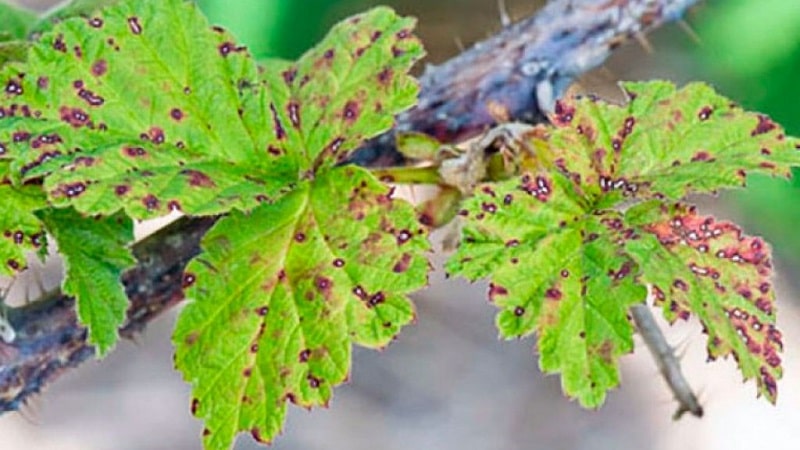
At the initial stage, small, barely noticeable dark spots appear. As the disease progresses, they increase in size and the leaf blades become deformed. At a later stage, the plant sheds its leaves.
To treat anthracnose, use a solution of Bordeaux mixture: 100 g of the drug per 10 liters of water. Treatment is carried out immediately after detection of stains and repeated after harvest. The same solution is also used to prevent the disease. Spraying is carried out in early spring before buds open.
To prevent anthracnose, it is not recommended to plant black currants where infected plants grew. In addition, it is necessary to promptly remove plant debris from the site.
Columnar rust
Columnar rust occurs as a result of the spread of the fungus Monilia Cronartium ribicola Dietr, which settles on the back of the leaves. Red growths appear on the greenery, and yellow spots appear on the upper part of the leaf. Columnar rust causes massive leaf loss and reduces crop yields.
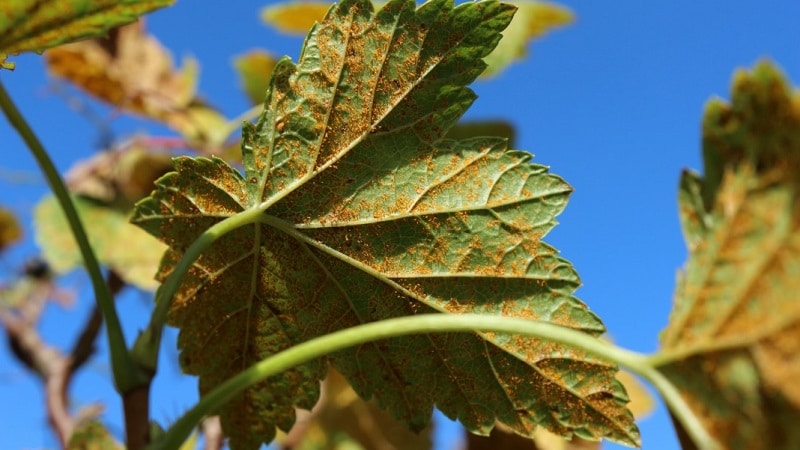
Infection with the fungus occurs in early spring, and gardeners notice the first signs in late July - early August.
In case of severe infection, the bushes are treated with fungicides (Bordeaux mixture, Nitrofen, Phthalan, Captan) according to the instructions on the package.
Prevention of infection requires compliance with a number of rules:
- Not plant currants in the neighborhood with coniferous trees.
- Plant varieties that are resistant to fungus.
- Collect and burn plant debris away from the site.
- Plow the soil in the tree trunk circle.
- In the spring, fertilize currants with potassium and phosphorus, as well as fertilizers with various microelements.
Tuberculariosis
Tubercularosis is an infectious disease caused by polyphage fungi Tubercularia vulgaris Tode. Most often they attack black currants. Mycelia spread throughout the bush in early spring and penetrate inside through damage to the bark of the shoots.
Note! The first thing that should alert a gardener is red lumpy spots on the inside of the leaf blade. Infection occurs in early spring, and the first signs are detected in late summer.
Damaged branches dry out, starting from the tops. Small bumps of red or dark brown color appear on them, resembling pads.
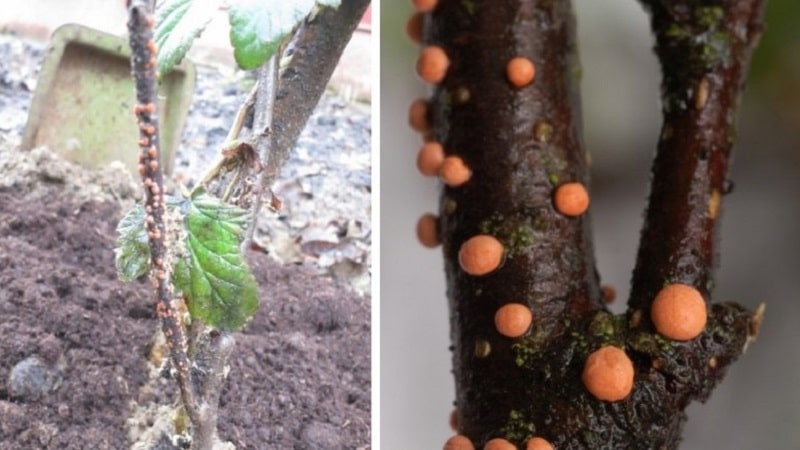
The fungus feeds on the contents of cells and causes them to die. The spores can withstand extremely low temperatures and are considered almost indestructible. In a neglected state, the plant dies due to necrosis of the bark.
To combat tuberculosis, use your choice of:
- 1% Bordeaux mixture;
- 0.5% Captanol solution;
- 0.4% solution of "Chomecin";
- 0.1% solution of "Topsin M".
The treatment is carried out after harvesting and again after 10 days.
Diseased and dry branches are cut to the ground and burned away from the site.
What to do if they are pests
To destroy pests, insecticides are mainly used, less often folk remedies.
Aphid
Red gall aphids are one of the most dangerous pests. Insects are found on bushes after the appearance of red spots and swellings in the central part of the leaf.The shoots of an infected plant are literally strewn with galls - red-brown growths, inside of which there are aphids.

Another sign of aphid infestation is the appearance of a large number of ants, which are attracted to the sticky secretions. To destroy aphids, use “Karbofos” or “Aktellik”.
Ticks
Spider mites settle on the back side of leaves and very quickly envelop the bush in a thin web. Mites suck out plant juices, resulting in the leaves are dryingcovered with brown spots, curl up and fly around. Spider mites rarely lead to the death of bushes, but they reduce the yield and winter hardiness of the crop.
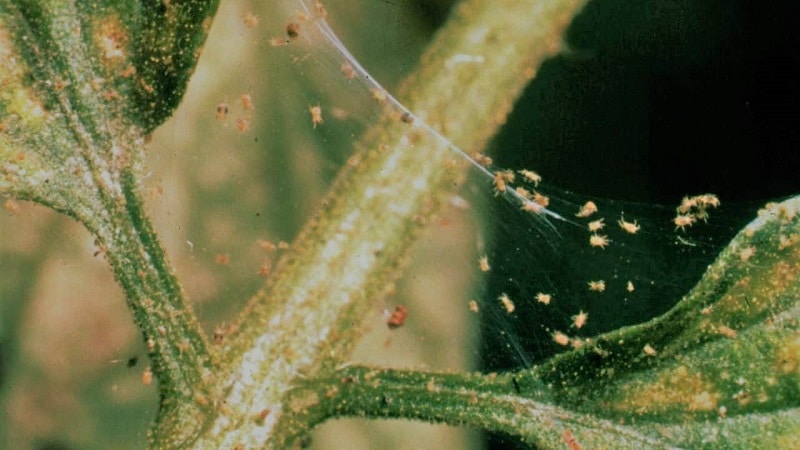
Kidney mite - another pest that likes to settle on black currants. The danger of the bud mite spreading is that the insect carries the terry virus, which can destroy the plant. The main symptoms of bud mite parasitism are thinning foliage, red spots, deformation of flowers and absence of fruit ovaries.
As the disease progresses, the following symptoms are observed:
- elongation, asymmetry, sharp teeth on the leaves;
- three-lobed leaf blades;
- reduction in the number of veins;
- purple foliage color;
- elongated flowers with narrow petals;
- lack of berries;
- presence of a characteristic odor.
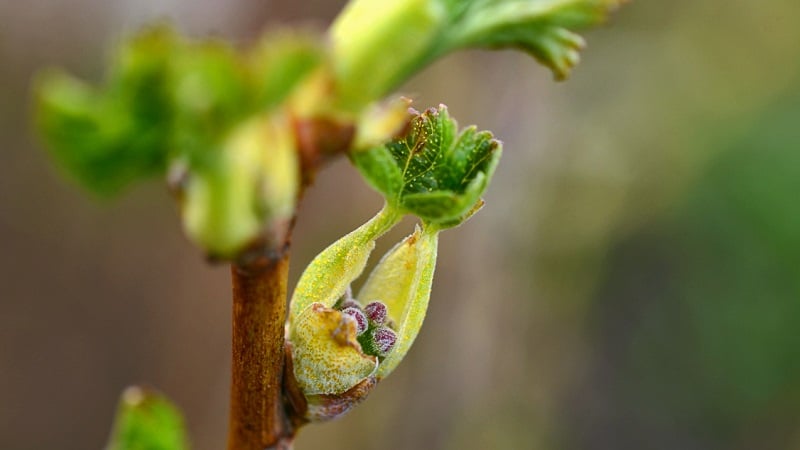
It is extremely difficult to identify the terry virus. Often, the first symptoms appear 3-4 years after infection.
Treating currants with insecticides or pruning does not produce positive results.
Important! There is no effective way to treat terry.
Infection with the terry virus can only be prevented:
- Only healthy and proven seedlings are planted on the site;
- the plant is fed with potassium and phosphorus to increase its defenses;
- in summer, nitrogen supplements are completely abandoned, which reduce immunity to the virus;
- After harvesting, currants are irrigated with Karbofos according to the instructions.
Glassware
The currant glass is a small black-brown butterfly with translucent wings. Thin light stripes are visible on the back and belly. The pest is found on bushes in June-July. The butterfly lays eggs, from which white caterpillars emerge. They penetrate inside the shoots, where they overwinter. By next autumn, the caterpillars grow up to 2 cm, but emerge to the surface another year later.
Advice. External influence is ineffective in the fight against glassware. Experienced gardeners recommend paying attention to prevention.
The most effective way is to spray the bushes with Glyphosate or Diosinon in early spring. The procedure is carried out until greenery appears. This will help get rid of some of the caterpillars and egg clutches.

It is important to strictly adhere to the timing of treatment and not to spray plants after the start of the growing season, since the preparations cause the death of foliage. If necessary, Glyphosate is used after the ovaries appear, as well as during the ripening period of the berries. However, only the soil is treated with the solution. Irrigation is carried out no later than a month before harvest.
Prevention of glassware:
- Loosening the soil in May - June. During this period, the larvae mature and rush inside the plants.
- Planting healthy seedlings from trusted nurseries.
- Pruning dry shoots when the first signs of infection are detected.
- Disorientation of the pest with decoctions of wormwood, garlic, onion peels, and orange peels.
- Planting onions, tomatoes, garlic, nasturtium, calendula, elderberries in the rows.
How to save currants
Let's look at an additional list of chemical and biological preparations, and also tell you how to prepare solutions based on natural ingredients.
Chemicals
Spraying currants is done once every 1-2 weeks. On average, 2-3 sprayings are required to cure a bush. Before starting the procedures, diseased and dry shoots are cut off.
The best chemicals are:
- "Topaz";
- 3% solution of Bordeaux mixture;
- 4% copper oxychloride solution;
- "Topsin M";
- "Aktara";
- 1% suspension of colloidal sulfur;
- "Skor";
- "Horus";
- 1% solution of copper sulfate.
Treatment with these products is carried out strictly according to the instructions, observing the dosage. The last spraying is carried out at least 3-4 weeks before harvest, since toxic substances can remain in the berries and cause poisoning.

Biological products
Biological products are absolutely safe for the environment, humans, bees, birds and pets. However, when using these products, it is also important to observe the dosage and processing time. The drugs are most effective at temperatures above +15°C. If it gets colder after processing, the currants are covered with film for 2-3 days to create a greenhouse effect.
List of effective drugs of biological origin:
- "Fitosporin";
- "Aktofit";
- "Nemabakt";
- “Fitoverm;
- "Fufanon."
If it rained or dew fell the next day, repeat the treatment.
Important! The berries can be eaten 14 days after processing.
Traditional methods
Folk remedies based on natural ingredients are less effective when compared with chemicals or biological products.However, they do not harm humans or pets. Solutions and infusions are suitable for preventive spraying and treatment of plants in the early stages of infection.
The most effective remedies that can rid a bush of brown spots:
- Iodine solution - 5% bottles of the drug per 10 liters of water.
- Nettle decoction. 200 g of fresh herbs in 3 liters of hot water, boil for 20 minutes, cool and strain, then walk through the greens.
- Infusion of wormwood, chamomile, dandelions, potato tops. Pour 300 g of raw material into 5 liters of boiling water, leave for 24 hours, strain and process the bushes.
- Laundry soap solution. 50 g of shavings per 10 liters of water.
- Citrus essential oils or pine extract. For 10 liters of water, 10-15 drops of lemon or orange essential oil or 35 ml of pine needle extract per 10 liters of water.
The products repel insects that spread fungal and viral infections or cause the appearance of brown, red and brown spots on the leaves as a result of their vital activity. Additionally, marigolds or mint can be planted between the rows to repel insects.
Agrotechnical techniques for prevention
If the cause of the appearance of brown spots on currants cannot be determined, it is recommended to use the following agricultural techniques:
- Trim dry branches.
- Apply complex fertilizer (nitrogen, potassium, phosphorus, magnesium).
- Check soil pH. Currants do not like soil with high acidity and react with a decrease in immunity. The first sign of high acidity is the abundance of horse sorrel in the area. In this case, slaked lime is added to the soil - 400 g per 1 m².
- Before bush pruning Disinfect instruments in a solution of potassium permanganate.
- In spring and autumn, dig up the tree trunk circle.
- Remove and burn fallen leaves.
- Carry out sanitary pruning.
- Treat the bushes with fungicides at the beginning of the growing season.
Is it possible to eat currants if they have brown spots?
Black currant berries can be eaten if treated with fungicides and insecticides a month before harvest. The berries are washed several times in warm water. After treatment with bacterial agents, currants can be eaten after 14 weeks.
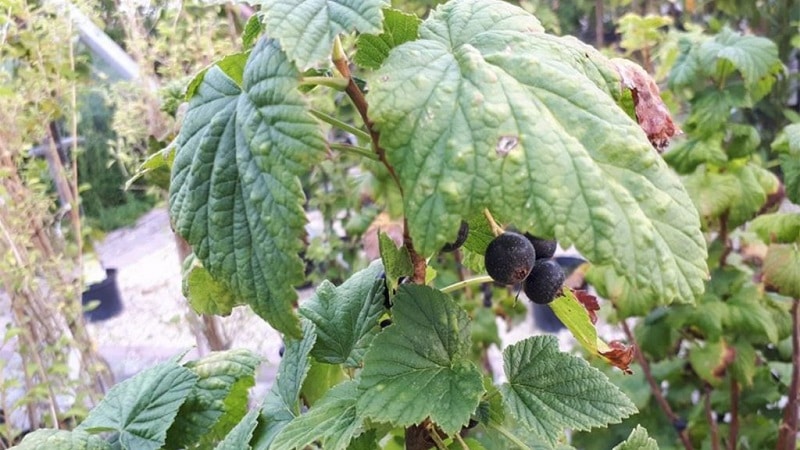
Useful tips
It is known that it is easier to prevent a disease than to treat it. Here's what experienced gardeners advise:
- To prevent infection of currant bushes with viral and fungal diseases, the cut and damage must be treated with garden varnish.
- It is recommended to dig onion and garlic peels under the bushes to repel insects.
- In the spring, before sap flow begins, plants are treated with pesticides and Bordeaux mixture against fungi.
- Pesticides should not be used in summer because the chemicals penetrate the berries and make them unfit for consumption.
- If there are not many insects on the site, it is recommended to wait until the harvest period and start cutting out damaged greenery or treat the bushes with an infusion of onions, celandine, garlic, tomato tops, and dandelion. To make the working solution stick better to the foliage, shavings of laundry soap are added to it.
- Not far from the currant plantation, it is advisable to leave an area with meadow grasses, which perfectly prevent the spread of aphids.
Conclusion
Brown spots and brown growths on currants are not uncommon. The reason for this is a violation of the rules of agricultural technology, neglect of the established norms of watering and adding nutrients.However, the most common cause is infection of bushes by viral and fungal infections, which are often carried by insect pests. Also, the gall aphid is known as a carrier of the terry virus, which is useless to fight.
The main tasks of a gardener are to monitor the condition of the plant, water it on time, feed it, remove weeds, loosen the soil and respond to the first signs of infection. Fungicides and bacterial preparations are used for treatment, and insecticides and folk remedies are used to kill insects.